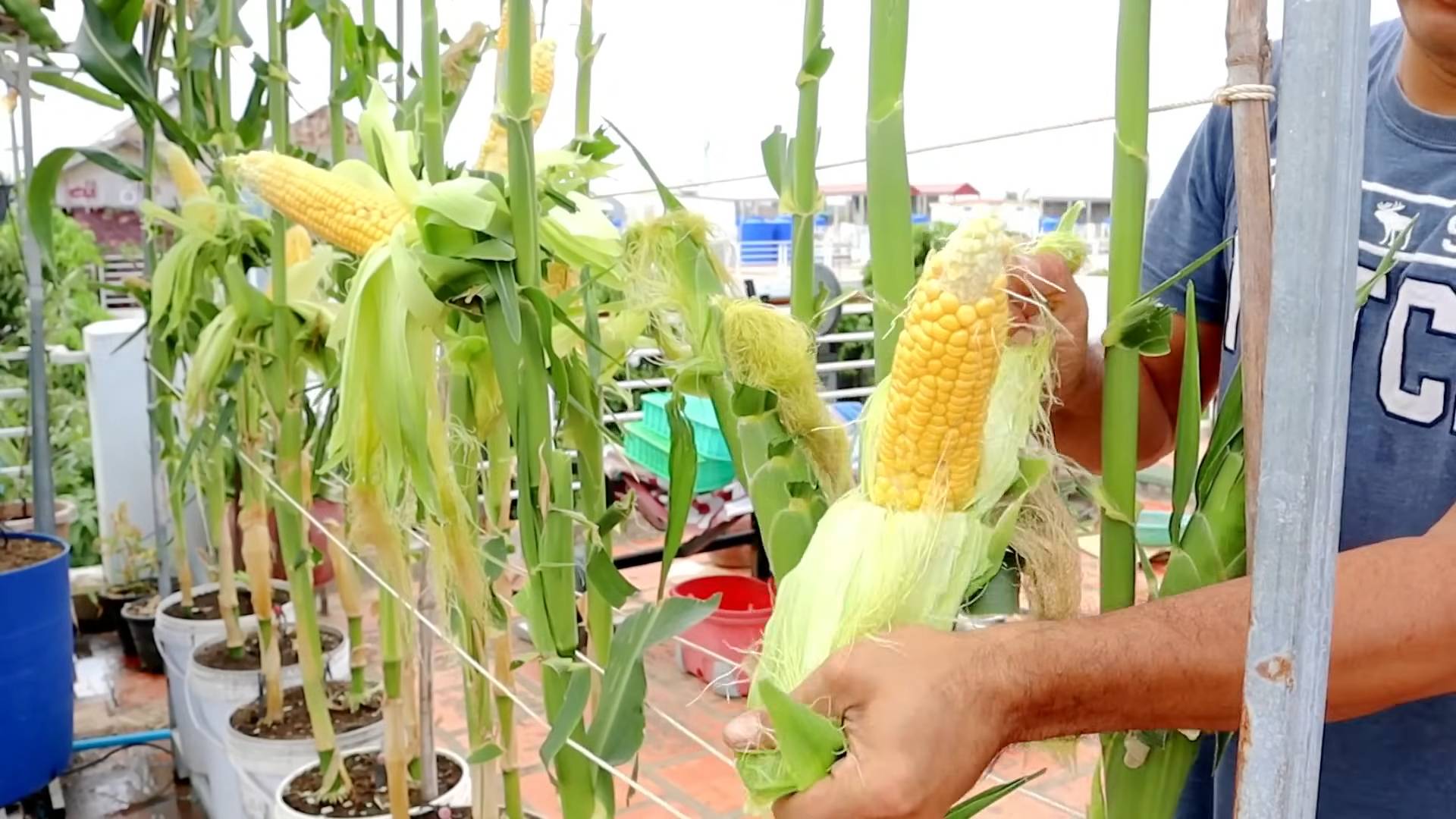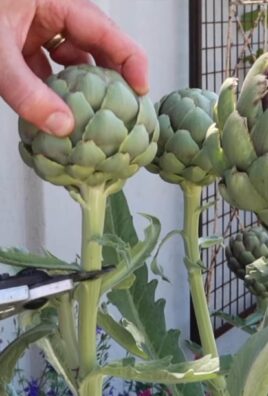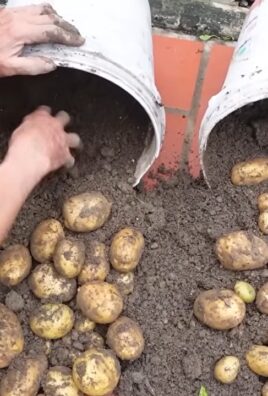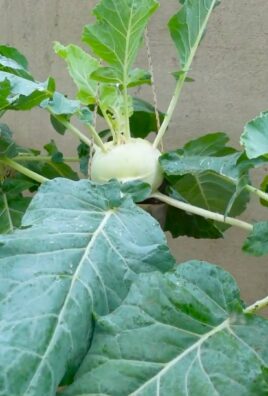Growing Sweet Corn in Containers might sound like a whimsical dream reserved for sprawling farms, but I’m here to tell you it’s absolutely achievable, even if your “farm” is a sunny balcony or a cozy patio! Forget the image of endless cornfields; we’re bringing the taste of summer right to your doorstep with this incredibly rewarding DIY project.
For centuries, corn has been a staple crop, deeply woven into the cultures of the Americas. From ancient civilizations to modern-day barbecues, its sweet, golden kernels have nourished and delighted generations. But what if you don’t have acres of land to dedicate to this iconic plant? That’s where the magic of container gardening comes in!
Let’s face it, fresh, homegrown sweet corn is simply unbeatable. The flavor explodes in your mouth in a way that store-bought corn just can’t replicate. But beyond the taste, there’s a deep satisfaction in nurturing a plant from seed to harvest. This DIY guide will walk you through every step of growing sweet corn in containers, from choosing the right variety to troubleshooting common problems. I’ll share all my secrets and tips to ensure you have a bountiful harvest of delicious, juicy corn, no matter how small your space. So, grab your gardening gloves, and let’s get started!

Growing Sweet Corn in Containers: A Sweet Success Story!
Hey there, fellow gardening enthusiasts! Ever dreamt of sinking your teeth into a juicy, homegrown ear of sweet corn, but thought you didn’t have the space? Well, I’m here to tell you that you absolutely CAN grow sweet corn, even if you only have a balcony, patio, or small yard! Container gardening opens up a world of possibilities, and sweet corn is no exception. I’ve done it, and trust me, the reward is worth the effort. Let’s dive into how you can grow your own sweet corn in containers.
Choosing the Right Variety and Container
Before we get our hands dirty, let’s talk about the key ingredients for success: the right corn variety and the perfect container.
* Variety Selection: Not all sweet corn varieties are created equal when it comes to container gardening. You’ll want to choose a shorter, more compact variety. Look for terms like “dwarf,” “short-stalked,” or “early maturing” in the seed description. Some excellent choices include:
* ‘On Deck’: A super-sweet variety that matures quickly.
* ‘Golden Bantam’: A classic, reliable choice with a smaller plant size.
* ‘Trinity’: Another compact variety known for its sweetness.
* ‘Early Sunglow’: A very early maturing variety, perfect for shorter growing seasons.
* Container Size: This is crucial! Sweet corn needs room for its roots to spread and anchor the plant. A single corn stalk needs at least 12 inches in diameter and 12 inches deep. I recommend using a container that’s at least 18-24 inches in diameter and 18-24 inches deep for multiple plants. Think large pots, half whiskey barrels, or even sturdy plastic tubs.
* Drainage: Absolutely essential! Make sure your container has plenty of drainage holes. Corn hates sitting in soggy soil. If your container doesn’t have enough holes, drill a few more.
Preparing the Soil and Planting
Now for the fun part – getting our hands dirty!
1. Gather Your Supplies:
* Your chosen sweet corn seeds.
* A large container (as described above).
* High-quality potting mix. Avoid using garden soil, as it can compact in containers. I like to use a mix specifically formulated for vegetables.
* Slow-release fertilizer.
* Watering can or hose.
* Optional: A small trowel or hand shovel.
2. Prepare the Potting Mix: Fill your container with the potting mix, leaving about 2-3 inches of space at the top. Mix in the slow-release fertilizer according to the package directions. This will provide your corn with a steady supply of nutrients throughout the growing season.
3. Planting the Seeds: Sweet corn is wind-pollinated, so you’ll need to plant multiple plants close together to ensure good pollination. I recommend planting at least 4-6 plants in a large container.
* Sow the seeds about 1-2 inches deep and 4-6 inches apart.
* Gently cover the seeds with potting mix and lightly pat down the soil.
4. Water Thoroughly: Water the container deeply until water drains out of the drainage holes. This will help settle the soil and ensure good seed-to-soil contact.
5. Location, Location, Location: Place your container in a location that receives at least 6-8 hours of direct sunlight per day. Sweet corn is a sun-loving plant, and it needs plenty of sunshine to thrive.
Caring for Your Container Corn
Once your corn seedlings emerge, it’s time to provide them with the care they need to grow into healthy, productive plants.
1. Watering: Sweet corn needs consistent moisture, especially during hot weather. Water deeply whenever the top inch of soil feels dry to the touch. Avoid overhead watering, as this can increase the risk of fungal diseases. I prefer to water at the base of the plants.
2. Fertilizing: Even with slow-release fertilizer, your corn may need an extra boost of nutrients during the growing season. About 4-6 weeks after planting, side-dress your corn with a nitrogen-rich fertilizer. Follow the package directions carefully. You can also use a liquid fertilizer every 2-3 weeks.
3. Thinning (If Necessary): If more than one seedling emerges from a single planting hole, thin them out to the strongest seedling. This will give the remaining plant more room to grow.
4. Supporting the Plants: As your corn plants grow taller, they may become top-heavy, especially in windy conditions. You can provide support by staking each plant with a sturdy bamboo stake or tomato cage. Tie the stalks loosely to the stakes with twine or plant ties.
5. Watch for Pests and Diseases: Keep an eye out for common corn pests like corn earworms, aphids, and spider mites. You can control these pests with insecticidal soap or neem oil. Also, watch for signs of fungal diseases like rust or leaf spot. Improve air circulation around the plants and avoid overhead watering to prevent these diseases.
Pollination: The Key to Sweet Corn Success
As I mentioned earlier, sweet corn is wind-pollinated, meaning the pollen from the tassels (the male flowers at the top of the plant) needs to land on the silks (the female flowers that emerge from the developing ears) for fertilization to occur. In a container setting, you may need to give nature a little nudge.
1. Hand-Pollination: When the tassels start to shed pollen and the silks emerge, you can hand-pollinate your corn. Gently shake the tassels over the silks to release the pollen. You can also cut off a tassel and gently brush it against the silks. Repeat this process every day for several days to ensure good pollination.
2. Timing is Everything: Pollen is typically shed in the morning, so that’s the best time to hand-pollinate.
3. Planting Density: Planting multiple plants close together increases the chances of successful pollination.
Harvesting Your Sweet Corn
The moment we’ve all been waiting for – harvesting our homegrown sweet corn!
1. Timing is Key: Sweet corn is ready to harvest about 20-25 days after the silks first appear. The silks will turn brown and dry, but they should still feel slightly moist.
2. The Feel Test: Gently feel the ear of corn through the husk. It should feel plump and full.
3. The Peek Test: Carefully peel back a small portion of the husk and poke a kernel with your fingernail. If the liquid that comes out is milky, the corn is ready to harvest. If the liquid is clear, it’s not quite ready. If the liquid is thick and doughy, it’s overripe.
4. Harvesting: To harvest, grasp the ear of corn firmly and twist it downward. It should snap off easily from the stalk.
5. Enjoy Immediately: Sweet corn is at its sweetest and most flavorful right after it’s harvested. Cook it as soon as possible for the best taste.
Troubleshooting Common Problems
Even with the best care, you may encounter some challenges when growing sweet corn in containers. Here are a few common problems and how to address them:
* Poor Pollination: If your ears of corn are not filling out properly, it could be due to poor pollination. Try hand-pollinating your corn as described above.
* Stunted Growth: Stunted growth can be caused by a lack of nutrients, insufficient sunlight, or root-bound plants. Make sure your corn is getting enough fertilizer and sunlight. If the roots are circling the bottom of the container, it may be time to transplant to a larger container.
* Pest Infestations: Keep an eye out for common corn pests and treat them promptly with insecticidal soap or neem oil.
* Disease Problems: Prevent fungal diseases by improving air circulation around the plants and avoiding overhead watering. If you notice signs of disease, treat with a fungicide.
Extra Tips for Success
* Choose the Right Potting Mix: A high-quality potting mix is essential for container gardening. Avoid using garden soil, as it can compact in containers and restrict root growth.
* Don’t Overwater: Overwatering can lead to root rot. Water deeply but infrequently, allowing the soil to dry out slightly between waterings.
* Rotate Your Crops: If you grow sweet corn in the same container year after year, the soil can become depleted of nutrients. Rotate your crops by planting different vegetables in the container each year.
* Succession Planting: For a continuous harvest of sweet corn, plant a new batch of seeds every 2-3 weeks.
Growing sweet corn in containers may seem daunting at first, but with a little planning and care, you can enjoy a bountiful harvest of delicious, homegrown corn. I hope this guide has inspired you to give it a try. Happy gardening!

Conclusion
So, there you have it! Growing sweet corn in containers might seem like a whimsical dream, but with a little planning and effort, it’s absolutely achievable. We’ve walked through the essential steps, from selecting the right container and variety to ensuring proper pollination and harvesting at the peak of sweetness.
Why is this DIY trick a must-try? Because it brings the joy of fresh, homegrown sweet corn to anyone, regardless of their access to a traditional garden plot. Imagine stepping onto your balcony or patio and picking perfectly ripe ears of corn, bursting with flavor, just minutes before dinner. That’s the magic of container gardening! It empowers you to connect with your food source, reduce your reliance on store-bought produce, and experience the satisfaction of nurturing something from seed to table.
Beyond the sheer convenience, growing sweet corn in containers offers a unique learning opportunity. You’ll gain a deeper understanding of plant life cycles, pollination processes, and the impact of environmental factors on crop yields. It’s a hands-on science lesson that’s both educational and rewarding.
Ready to take your container gardening to the next level? Consider these variations and suggestions:
* Succession Planting: Plant new seeds every few weeks to extend your harvest season. This ensures a continuous supply of fresh sweet corn throughout the summer.
* Companion Planting: Experiment with companion plants like beans or squash in the same container. These plants can help improve soil health, deter pests, and even provide support for your corn stalks.
* Fertilizer Adjustments: Monitor your plants closely and adjust your fertilizer regimen as needed. Sweet corn is a heavy feeder, so be prepared to provide supplemental nutrients throughout the growing season.
* Variety Selection: Don’t be afraid to try different varieties of sweet corn to find your favorites. Some varieties are better suited for container growing than others, so do your research and experiment! Look for shorter, more compact varieties.
* Pollination Assistance: If you’re struggling with pollination, try hand-pollinating your corn. Simply collect pollen from the tassels and gently brush it onto the silks of the developing ears.
Ultimately, the best way to learn is by doing. Don’t be intimidated by the prospect of growing sweet corn in containers. Embrace the challenge, experiment with different techniques, and learn from your mistakes. The rewards – fresh, delicious sweet corn and a newfound appreciation for the wonders of nature – are well worth the effort.
We’re confident that you’ll find this DIY trick to be a game-changer for your gardening endeavors. So, grab your containers, seeds, and soil, and get ready to embark on a sweet corn adventure!
We’d love to hear about your experiences growing sweet corn in containers. Share your tips, tricks, and photos in the comments below. Let’s create a community of container corn growers and inspire others to give it a try! What variety did you choose? What challenges did you face? What successes did you celebrate? Your insights can help others achieve their container gardening goals. Happy growing!
Frequently Asked Questions (FAQ)
What is the best variety of sweet corn to grow in containers?
Choosing the right variety is crucial for success when growing sweet corn in containers. Look for varieties specifically bred for smaller spaces or shorter growing seasons. “On Deck,” “Golden Midget,” and “Trinity” are popular choices known for their compact size and early maturity. These varieties typically produce smaller ears, but they are still packed with flavor. Read seed descriptions carefully to understand the plant’s mature height and space requirements before making your selection. Consider also the climate you live in and choose a variety that is well suited for your region.
How large of a container do I need for sweet corn?
Sweet corn requires a substantial amount of space for its roots to develop properly. A minimum of 12 inches in diameter and 12 inches deep is recommended for each plant. However, larger containers, such as 15-20 gallon pots, are even better as they provide more room for root growth and help retain moisture. If you’re planting multiple corn stalks in the same container, ensure there’s adequate spacing between them (about 8-12 inches) to prevent overcrowding. Using a container that is too small will result in stunted growth and reduced yields.
How often should I water my container-grown sweet corn?
Sweet corn is a thirsty plant, especially when grown in containers. During hot weather, you may need to water your corn daily, or even twice a day, to keep the soil consistently moist. Check the soil moisture regularly by sticking your finger about an inch deep. If the soil feels dry, it’s time to water. Avoid overwatering, which can lead to root rot. Ensure your container has adequate drainage holes to prevent water from pooling at the bottom. A good rule of thumb is to water deeply until you see water draining from the bottom of the container.
How do I pollinate sweet corn in containers?
Pollination is essential for sweet corn to produce kernels. In a traditional garden, wind typically carries pollen from the tassels (the male part of the plant) to the silks (the female part of the plant). However, in a container setting, you may need to assist with pollination. When the tassels begin to shed pollen, gently shake the stalks to release the pollen. You can also use a small paintbrush to collect pollen from the tassels and manually brush it onto the silks. Repeat this process every day for about a week to ensure adequate pollination. If you notice that the silks are turning brown and dry, it means they have been pollinated.
What kind of fertilizer should I use for sweet corn in containers?
Sweet corn is a heavy feeder and requires a nutrient-rich soil to thrive. Before planting, amend your potting mix with compost or well-rotted manure to provide a slow-release source of nutrients. During the growing season, fertilize your corn every 2-3 weeks with a balanced fertilizer (e.g., 10-10-10) or a fertilizer specifically formulated for vegetables. Follow the instructions on the fertilizer package carefully to avoid over-fertilizing, which can burn the roots. You can also supplement with liquid seaweed or fish emulsion to provide micronutrients.
How do I know when my sweet corn is ready to harvest?
Harvesting at the right time is crucial for enjoying the best flavor and texture of your sweet corn. The silks will turn brown and dry, but this is not the only indicator. Feel the ears of corn; they should be plump and filled out. Gently peel back a portion of the husk and puncture a kernel with your fingernail. If a milky liquid squirts out, the corn is ready to harvest. If the liquid is clear, the corn is not yet ripe. If the liquid is thick and doughy, the corn is overripe. Once you’ve determined that the corn is ready, twist the ear downward and snap it off the stalk.
Can I grow sweet corn in containers indoors?
While it’s possible to start sweet corn seeds indoors, it’s not recommended to grow them to maturity indoors. Sweet corn requires a significant amount of sunlight (at least 6-8 hours per day) to thrive, which is difficult to provide indoors, even with grow lights. Additionally, sweet corn plants can grow quite tall, making them unsuitable for most indoor spaces. It’s best to grow sweet corn in containers outdoors, where they can receive ample sunlight and air circulation.
What are some common pests and diseases that affect sweet corn in containers?
Common pests that can affect sweet corn include corn earworms, aphids, and spider mites. Regularly inspect your plants for signs of infestation and take action promptly. You can use insecticidal soap or neem oil to control these pests. Diseases that can affect sweet corn include rust and smut. Ensure good air circulation around your plants to prevent fungal diseases. Remove any infected leaves or stalks promptly to prevent the spread of disease. Choosing disease-resistant varieties can also help minimize problems.
How many corn stalks should I plant in one container?
While it might be tempting to cram as many corn stalks as possible into a single container, it’s important to provide adequate space for each plant to thrive. Generally, it’s best to plant no more than 3-4 corn stalks in a large container (15-20 gallons). Overcrowding can lead to stunted growth, reduced yields, and increased susceptibility to pests and diseases. Ensure there’s at least 8-12 inches of space between each plant to allow for proper air circulation and root development.
What do I do with the corn stalks after harvesting the ears?
After harvesting the ears of corn, you can cut the stalks down to the base. You can then chop up the stalks and add them to your compost pile or use them as mulch in your garden. The stalks are rich in nutrients and will decompose over time, enriching the soil. Alternatively, you can leave the stalks standing in the container as a decorative element in your garden.





Leave a Comment